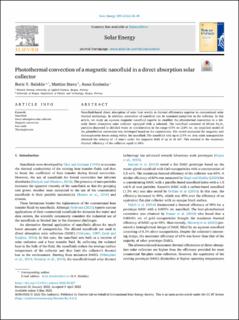Photothermal convection of a magnetic nanofluid in a direct absorption solar collector
Journal article, Peer reviewed
Published version

Åpne
Permanent lenke
https://hdl.handle.net/11250/3001415Utgivelsesdato
2022Metadata
Vis full innførselSamlinger
Sammendrag
Nanofluid-based direct absorption of solar heat results in thermal efficiencies superior to conventional solar thermal technology. In addition, convection of nanofluid can be sustained pump-free in the collector. In this article, we study an aqueous magnetic nanofluid capable to establish the photothermal convection in a lab-scale direct absorption solar collector equipped with a solenoid. The nanofluid consisted of 60-nm Fe2O3 particles dispersed in distilled water at concentration in the range 0.5% wt.-2.0% wt. An empirical model of the photothermal convection was developed based on the experiments. The model accounted for magnetic and thermophoretic forces acting within the nanofluid. The nanofluid with up to 2.0% wt. iron oxide nanoparticles obtained the velocity of ∼5 mm/s under the magnetic field of up to 28 mT. This resulted in the maximum thermal efficiency of the collector equal to 65%.
